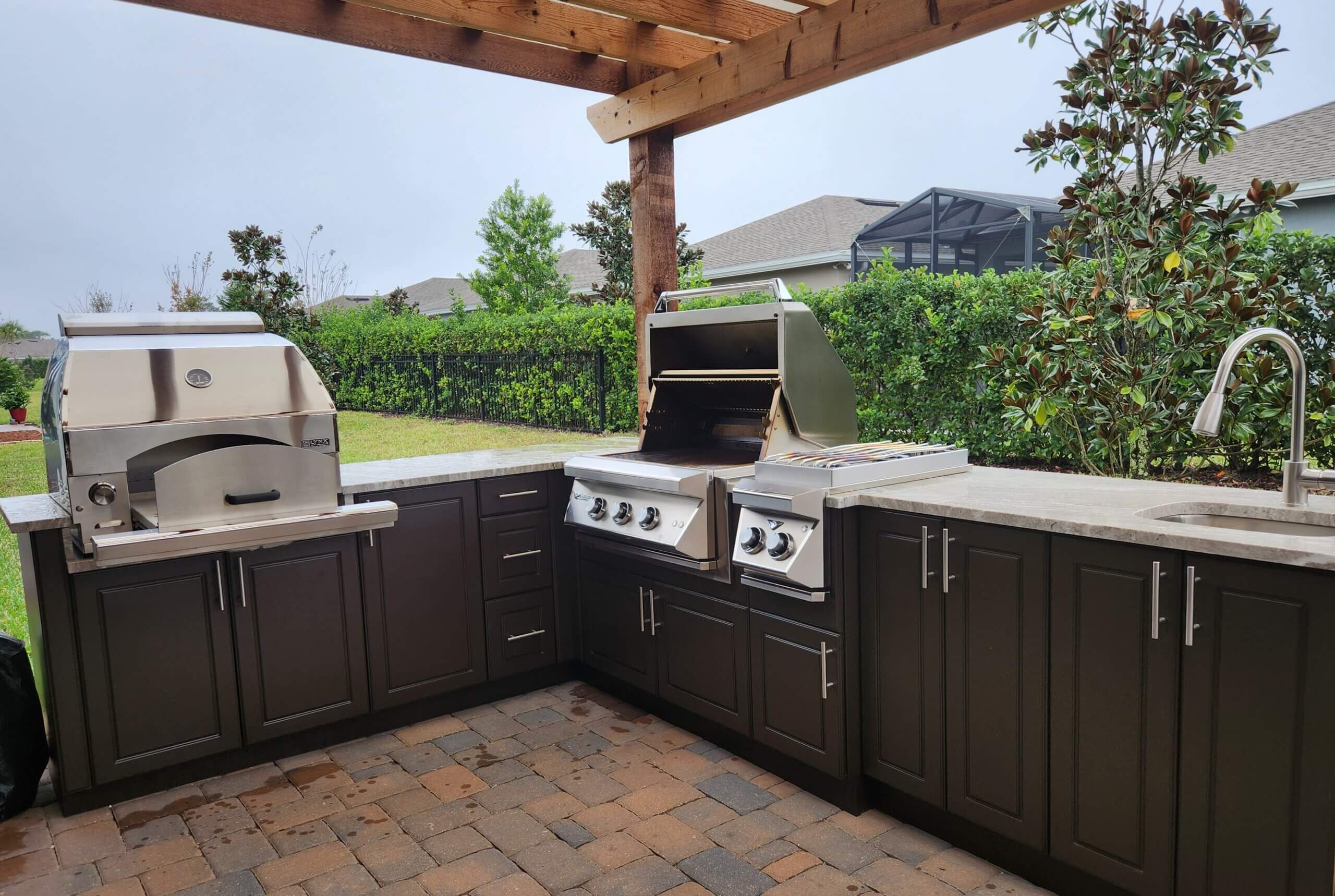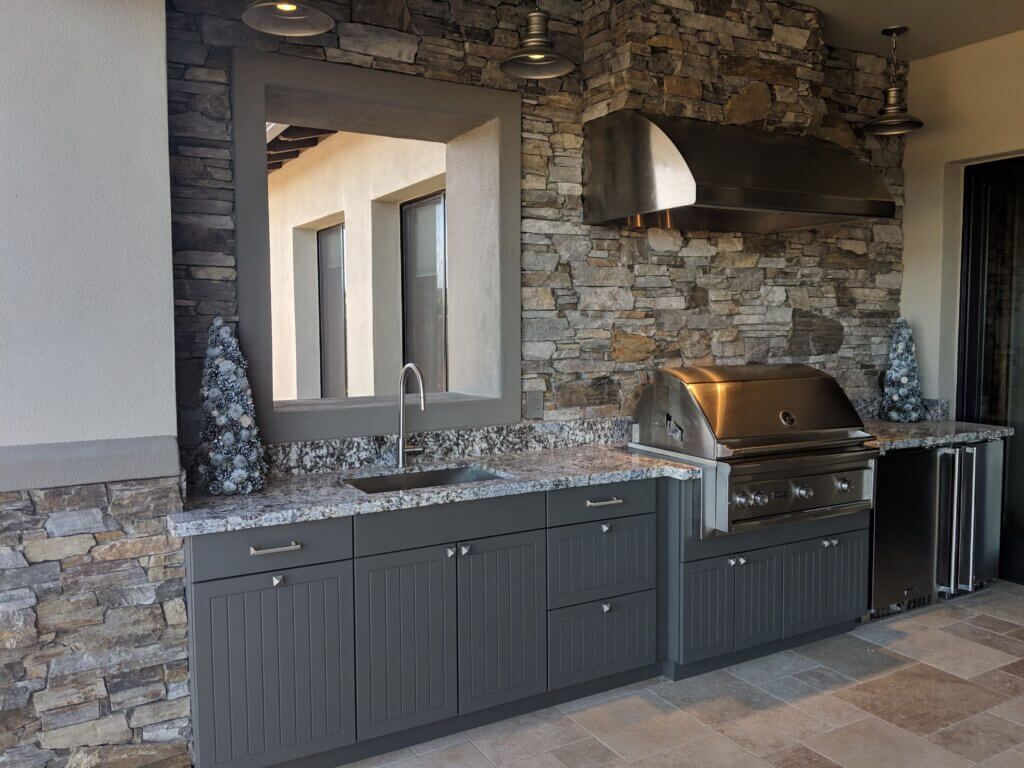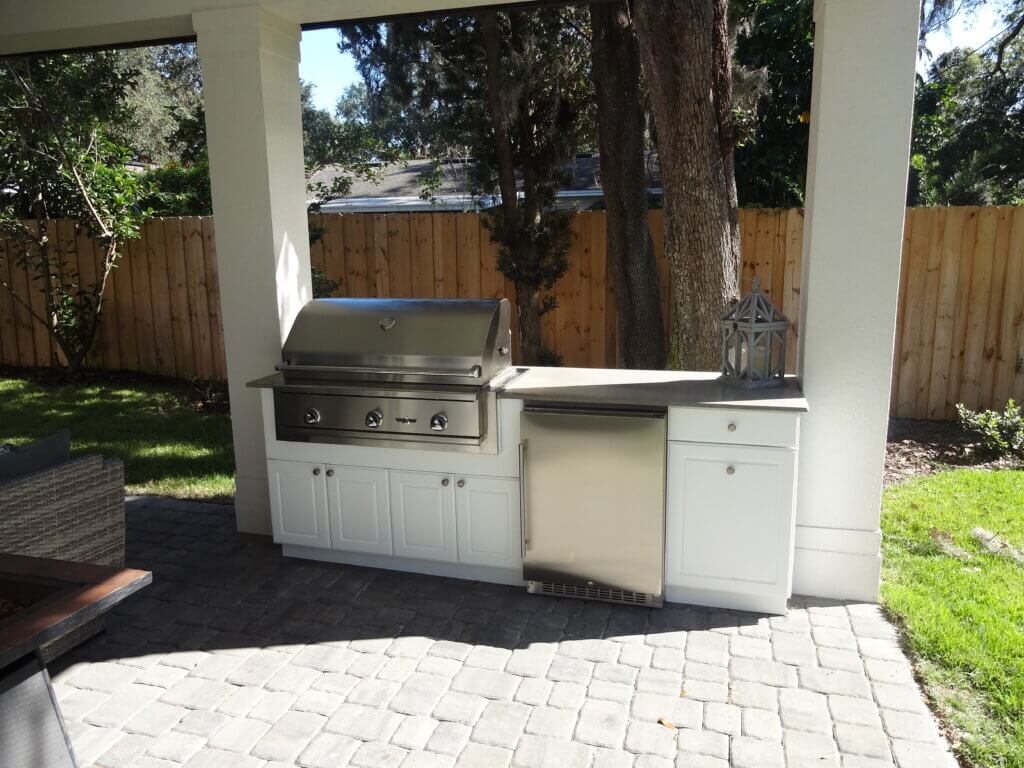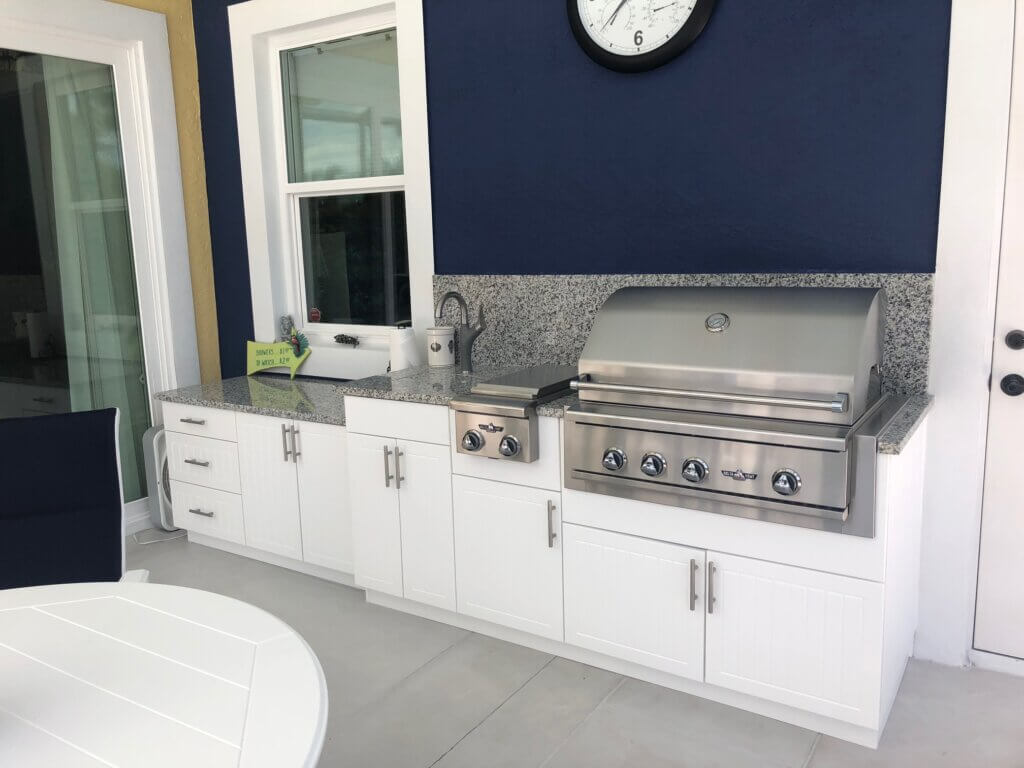Questions To Ask Before Beginning Your Outdoor Kitchen Project
What The Pros Want You To Know Before You Start

Any major home renovation project can seem daunting, and building an outdoor kitchen is no exception. After all, you’re making a significant investment in both time and money; it’s only natural to want to ensure that you’re making the best possible choices.
Sometimes the most important thing to know from the start is which questions you should be asking. That’s why we’ve put together this guide to get you started on your outdoor kitchen journey!
Questions
General Outdoor Kitchen Questions
When it comes to outdoor kitchens, there are often questions that arise. From design considerations to practicalities, understanding the ins and outs of creating an outdoor culinary oasis can be beneficial. Whether you’re curious about suitable materials, appliance options, or maintenance tips, exploring these common inquiries will help you make informed decisions while planning your dream outdoor kitchen.
Are outdoor kitchens waterproof?
Creating a weatherproof outdoor kitchen requires some additional care and attention. However, by planning ahead, selecting durable materials, and strategically placing each appliance, you can prevent many common issues and safeguard your outdoor space. Werever’s waterproof cabinetry offers a convenient solution – they can be easily washed with a hose on both the inside and outside surfaces. With just a hose or power washer, you can effectively clean them. Moreover, these cabinets require significantly less maintenance, saving you time and effort. Invest in reliable and low-maintenance options like Werever’s waterproof cabinetry to ensure the longevity and protection of your outdoor kitchen.
How far does an outdoor kitchen need to be from the house?
It is often recommended to position an outdoor kitchen around 15 to 20 feet away from your indoor kitchen. This distance strikes a balance between convenience and separation, allowing for easy access and flow between the two spaces. With this setup, you can effortlessly transition between indoor and outdoor cooking while enjoying distinct environments for different culinary experiences. Keeping your outdoor kitchen within this range ensures practicality and enhances the overall functionality of your culinary setup.
Do I need a permit for an outdoor kitchen?
While you technically don’t need a permit for an outdoor kitchen, you will likely need one if you’re planning to undertake significant electrical or plumbing work. Keep in mind that the necessity of a permit for small electrical and plumbing projects may vary depending on your location. It’s always advisable to check with your local authorities to determine if a permit is required.
Other cases where permits may be necessary are if there are sewer, water, electric, or gas connections involved. In such cases, a simple permit and inspection process is usually required to ensure compliance with safety regulations.
Is quartz good for an outdoor kitchen countertop?
Quartz countertops are perfect for outdoor kitchens because they require minimal maintenance. You don’t need to worry about sealing them, and a simple wipe-down every so often will keep them looking great.
Quartz countertops add an elegant touch to outdoor living areas, providing both durability and a stylish surface for entertaining guests. They can withstand extreme temperatures and offer a sturdy foundation for your outdoor gatherings.
Choosing Outdoor Cabinets
The cabinets that you ultimately select for your outdoor kitchen will play a huge role in determining the overall aesthetic appeal, functionality, and durability of your outdoor kitchen.
What is the best material for outdoor kitchen cabinets?
When it comes to style and durability, the best option for custom outdoor cabinets is marine-grade High-Density Polyethylene (HDPE), a cutting-edge polymer engineered to withstand direct exposure to rain, snow, and extreme temperatures, whether hot or cold.
Unlike wood or steel cabinetry, these cabinets will not split, fade, crack, chalk, rust, absorb water, or swell. With their durability and resistance, Werever’s outdoor kitchen cabinets offer both functionality and beauty. Carefully designed and engineered specifically for outdoor use, they provide a high-end solution for your outdoor cooking needs.
Do stainless steel cabinets in an outdoor kitchen rust?
Stainless steel is composed of iron, which can be vulnerable to rusting when exposed to outdoor conditions. However, it also contains a minimum of 10.5% chromium, which aids in preventing rust formation. However, regular cleaning is necessary to maintain the appearance of bare stainless steel, which adds significant maintenance requirements.
Can wood be used for outdoor kitchen cabinets?
When it comes to outdoor cooking spaces, purchasing wood cabinets may not be the most practical choice unless your space is covered, and even then it’s not ideal. Wood can be expensive and requires more maintenance compared to other materials used for outdoor kitchen cabinets.
What cabinet configurations can you use in an outdoor kitchen?
It’s important to consider things like available space, traffic flow, location of power/water supply, etc. when deciding on a layout, but there are a lot of options available! Some popular configurations include L-shaped, U-shaped, straight line, and a kitchen island layout.
Be sure to talk with an expert when deciding on your kitchen layout, as they can help you choose the layout that provides the most functionality while matching your vision of your perfect outdoor kitchen.
Vent Hood and Plumbing for Your Outdoor Kitchen
Both vent hoods and plumbing are essential components that contribute to the functionality and enjoyment of an outdoor kitchen.

Can you install a range hood vent yourself?
Typically, range hoods come with a three-pronged plug for easy power connection that you can handle yourself. However, if your range hood doesn’t have a plug, you may require the assistance of an electrician or a contractor with electrical expertise to hardwire it. While any contractor should be able to install your range hood, it’s recommended to hire an electrician or HVAC professional if the installation involves new ductwork or electrical wiring. Their specialized knowledge will ensure a smooth and safe installation process for your new range hood.
What size vent pipe do you need for a range hood?
For range hoods with a CFM (cubic feet per minute) rating of 400 or less, the recommended minimum duct size is 4 inches. As the CFM increases, the duct size should also increase. For a range hood with a CFM of 600, the minimum duct size should be 6 inches. Similarly, for a CFM of 900, the minimum duct size should be 8 inches. It’s important to choose the appropriate duct size to ensure optimal ventilation and airflow in your outdoor kitchen.
How do you run plumbing to an outdoor kitchen?
To have a sink in your outdoor kitchen, you’ll need both a water line for fresh water and a drain pipe for wastewater. You have two options for the water line: connecting it to your main home water supply or installing a separate line dedicated to your outdoor kitchen. Either way, ensuring proper water flow and drainage will allow you to fully enjoy the functionality of your outdoor sink while maintaining a clean and efficient cooking space.
What is the best sink placement for an outdoor kitchen?
The placement of an outdoor sink is often determined by drainage and water source availability. A common choice is to position it along the back or side of the house, as this allows for convenient access to the kitchen and typically where water pipes are located. This location ensures easy connectivity and accessibility while optimizing the practicality of your outdoor sink setup.
Do you need a permit to add plumbing?
Yes, it is essential for plumbing systems to adhere to the relevant sanitary, safety, and plumbing codes in your specific location. Compliance with these codes ensures that the plumbing work meets the necessary standards for sanitation and safety.
The Power to Run Your Outdoor Kitchen
Having a reliable power source is crucial for the functionality and convenience of your outdoor kitchen. Power is essential for operating appliances such as grills, refrigerators, and lighting fixtures. It ensures that you can enjoy seamless cooking experiences and maintain food safety while creating a comfortable and well-lit environment for outdoor dining and entertaining.

How do you get power to an outdoor kitchen?
To ensure the safe and proper installation of power for your outdoor kitchen, it is highly recommended to hire a professional electrician. Attempting to handle the electrical work yourself can be dangerous, especially when dealing with outdoor environments. By hiring a professional, you can rely on their expertise to efficiently and safely run or install the power for your outdoor kitchen, minimizing the risk of potential hazards.
Can an outdoor kitchen be solar-powered?
Absolutely! You have the option to incorporate a portable solar generator or install solar panels in your backyard to power your outdoor kitchen. This eco-friendly solution allows for easy setup and provides a sustainable energy source for your outdoor culinary adventures. Whether you choose a portable solar generator or opt for solar paneling, you can enjoy the benefits of harnessing solar power to fuel your outdoor cooking space.
Can you run a gas line to an outdoor kitchen?
When it comes to running a gas line for an outdoor kitchen, it is crucial to enlist the assistance of a professional gas technician. This task can be intricate and should not be attempted as a do-it-yourself project. It is essential to hire a licensed and certified individual to ensure that the fuel gas work is conducted safely and in compliance with regulations. Seeking the expertise of a professional will provide peace of mind and guarantee a successful installation.
How much should I pay for a gas-connected grill?
The finest grills on the market feature 304 stainless steel construction, meticulously crafted to withstand even the most demanding environments and ensure long-lasting performance. Many of these grills are powered by gas and can be connected directly to your house, eliminating the need for propane tanks. If you’re considering a gas-connected outdoor kitchen, anticipate a budget ranging from $1,500 to $10,000 for a high-performance grill. Additionally, investing an extra $500 to $1,200 for an insulating jacket is advisable for enhanced functionality and protection. Learn more about budgeting for an outdoor kitchen: How Much Should You Expect To Spend On An Outdoor Kitchen In 2023?

